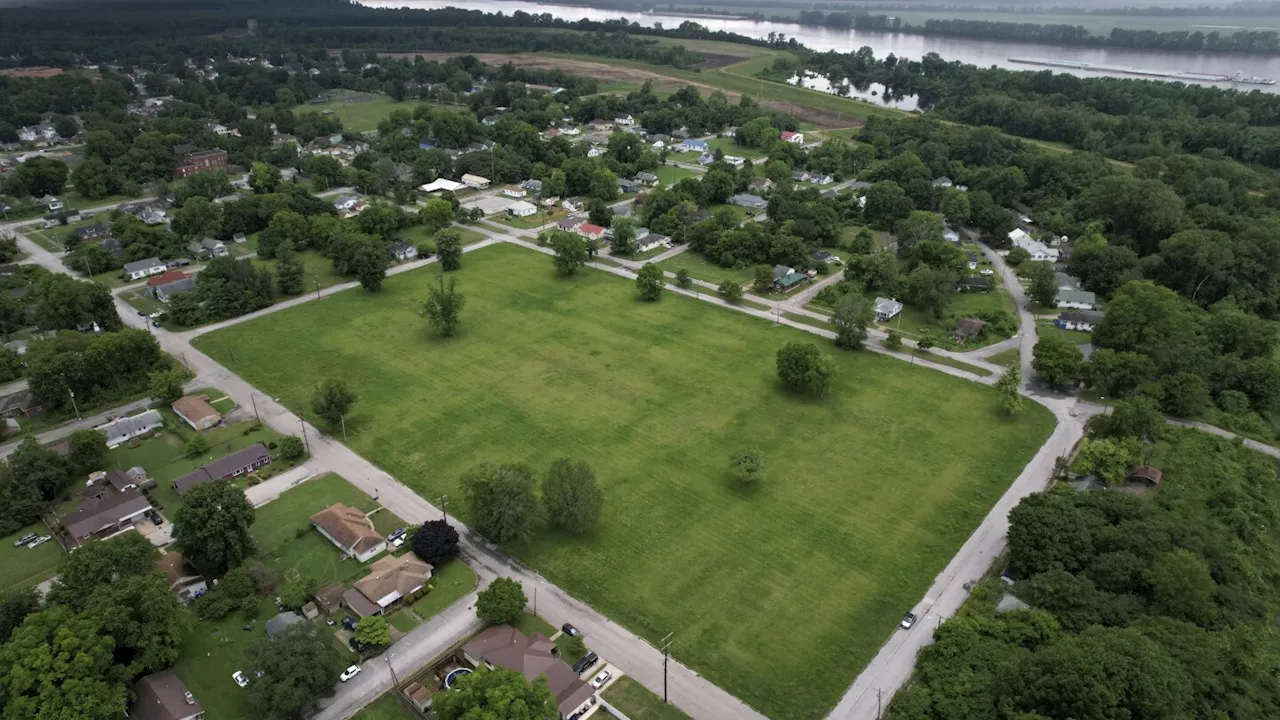Biden hopes the same waterways that spurred westward expansion can cut greenhouse gas emissions. Environmentalists aren’t so sure.
In the story of America, the Mississippi River is a character unto itself, a rough-hewn founding father of the West: restless, implacable, more powerful than law or nature.
The first of these structures — walls of concrete that can stretch a third of a mile from bank to bank — went up just before Twain died in 1910. “When I voted for the bipartisan infrastructure bill, I was voting for exactly this type of federal support for critical infrastructure that Iowans depend on,” boasted Sen. Chuck Grassley after the Biden administration sent nearly $830 million to a pair of lock and dam projects near and dear to corn and soybean growers in the region.
Train tracks cross at America’s Central Port in Granite City, Illinois, just across the river from St. Louis. Champions of heartland commerce point to the intersection of highways, waterways and railways here as a reason to call the region America’s “ag coast.” The HFL Mariner and the remaining six barges wait to enter Lock 25 after the first nine of its barges are uncoupled and sent through the lock .40 percent of the mainland United States flows into the Mississippi River, which means 31 states between the Appalachian Mountains and the Rockies send their rainfall and snowmelt into its maw.
The essence of water management is to make a waterway carved by nature into something more controllable by man. Locks are essentially elevators for boats — a vessel goes into a chamber that either empties water to ease the boat downstream or fills with water to lift the boat for travel upstream. To make the ebb and flow of the Mississippi more predictable, the U.S. Army Corps of Engineers built 29 locks and dams north of St. Louis, in the places where the river is least predictable.
Now, the vestiges of the concrete locks are crumbling and inefficient, both too narrow and too short for today’s tugs hauling dozens of barges. They slow the pace of commerce and mitigate some of the cost advantages of hauling goods by barge over other forms of transport. Lock and Dam 25 — just “Twenty-Five” to those who talk often about such things — is beyond a clump of trees on a Missouri cornfield’s eastern edge, straddling the river as it separates Illinois from Missouri.
Boats on the Mississippi now tow a dozen or more barges where they used to tow nine. It’s impossible to move that many barges through a small lock like Twenty-Five without a whole bunch of strenuous and often dangerous work. There is also the matter of foreign competition. Other countries that export agricultural products are making their own improvements to river transportation, cutting the costs of sending their products overseas. America’s growers suffer in comparison.
Paducah, Kentucky, is one such example. In addition to being the quilt-making capital of the U.S., Paducah was quite literally forged by the rivers. A massive flood wall holds back the river, while a small town in middle America churns on behind it. Despite having to use a winch as a backup method to operate lock gates at Kentucky Lock, it is in the midst of a renaissance thanks to a powerful advocate: Sen. Mitch McConnell.
Construction workers hang high above the hole on cranes and platforms, and buzzing beneath them are excavators and trucks shuffling earth. The project has been going on for nearly two decades, with fits and starts due to financial constraints. But it was recently funded to completion by the bipartisanWhen it’s complete, the new and larger lock and dam will ease congestion at Kentucky Lock significantly, making long backups a thing of the past.
In fact, it costs nothing for anyone to use the locks, which is one of the reasons there wasn’t much money sitting around for them as they fell apart. Instead, repairs and maintenance are funded by a tax on fuel that barges use. At 29 cents a gallon, it’s still less than the state gas taxes many car drivers across the country pay. The fund has been chronically depleted.
But there’s a new obstacle: Critics in the environmental movement aren’t so sure all the claims about how great shipping is for the environment hold up. But there is a real fight brewing because, two decades ago, environmental groups in the upper Mississippi, including The Nature Conservancy, struck a deal with the Army Corps and the shipping industry: They would drop objections to major lock and dam upgrades if projects to restore nature were just as well funded as lock and dam projects.
Lock advocates argue the figures look the way they do because locks require large upfront capital costs. But Pfeiffer, who has been working on the issue for decades, is worried that the trend won’t change.
United Kingdom Latest News, United Kingdom Headlines
Similar News:You can also read news stories similar to this one that we have collected from other news sources.
 Podcast: State Democratic Chair Taylor remains committed to BidenMississippi Today interviews Mississippi Democratic Party Chairman Cheikh Taylor about President Joe Biden’s debate performance.
Podcast: State Democratic Chair Taylor remains committed to BidenMississippi Today interviews Mississippi Democratic Party Chairman Cheikh Taylor about President Joe Biden’s debate performance.
Read more »
 20 Chewy Products For Large Dog OwnersOur big dogs should give us big lovin', not big headaches.
20 Chewy Products For Large Dog OwnersOur big dogs should give us big lovin', not big headaches.
Read more »
 Idaho freedom celebration billed as largest fireworks show west of Mississippi RiverThe largest fireworks show west of the Mississippi River is returning this year for the Melaleuca Freedom Celebration and organizers says it will 'be bigger and better than any other fireworks show in the American West.
Idaho freedom celebration billed as largest fireworks show west of Mississippi RiverThe largest fireworks show west of the Mississippi River is returning this year for the Melaleuca Freedom Celebration and organizers says it will 'be bigger and better than any other fireworks show in the American West.
Read more »
 ‘The Great River’ explores the beauty and power of the MississippiThe narrative Boyce Upholt constructs engages with the wildness of the river while also explaining the the forces that have long sought to tame it.
‘The Great River’ explores the beauty and power of the MississippiThe narrative Boyce Upholt constructs engages with the wildness of the river while also explaining the the forces that have long sought to tame it.
Read more »
 For shrinking Mississippi River towns, frequent floods worsen fortunesFlooding has pushed people out of their homes near the Mississippi River at a roughly 30% higher rate than the U.S. as a whole. That’s hurting a region that is already growing slower than the rest of the country.
For shrinking Mississippi River towns, frequent floods worsen fortunesFlooding has pushed people out of their homes near the Mississippi River at a roughly 30% higher rate than the U.S. as a whole. That’s hurting a region that is already growing slower than the rest of the country.
Read more »
 Takeaways from AP examination of flooding's effect along Mississippi RiverFlooding has pushed people out of their homes near the Mississippi River at a roughly 30% higher rate than the U.S. as a whole, according to data provided exclusively to The Associated Press by the risk analysis firm First Street.
Takeaways from AP examination of flooding's effect along Mississippi RiverFlooding has pushed people out of their homes near the Mississippi River at a roughly 30% higher rate than the U.S. as a whole, according to data provided exclusively to The Associated Press by the risk analysis firm First Street.
Read more »
